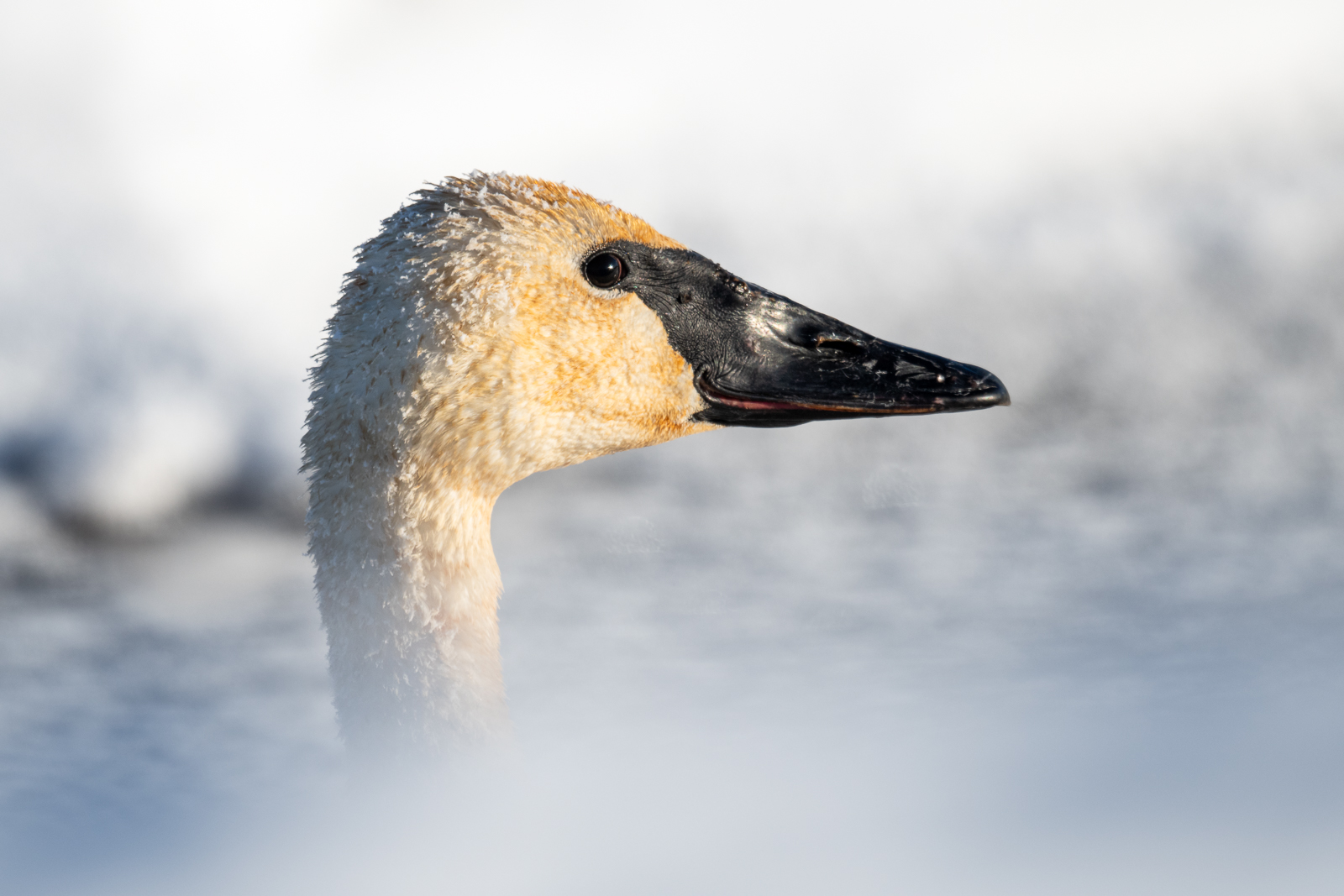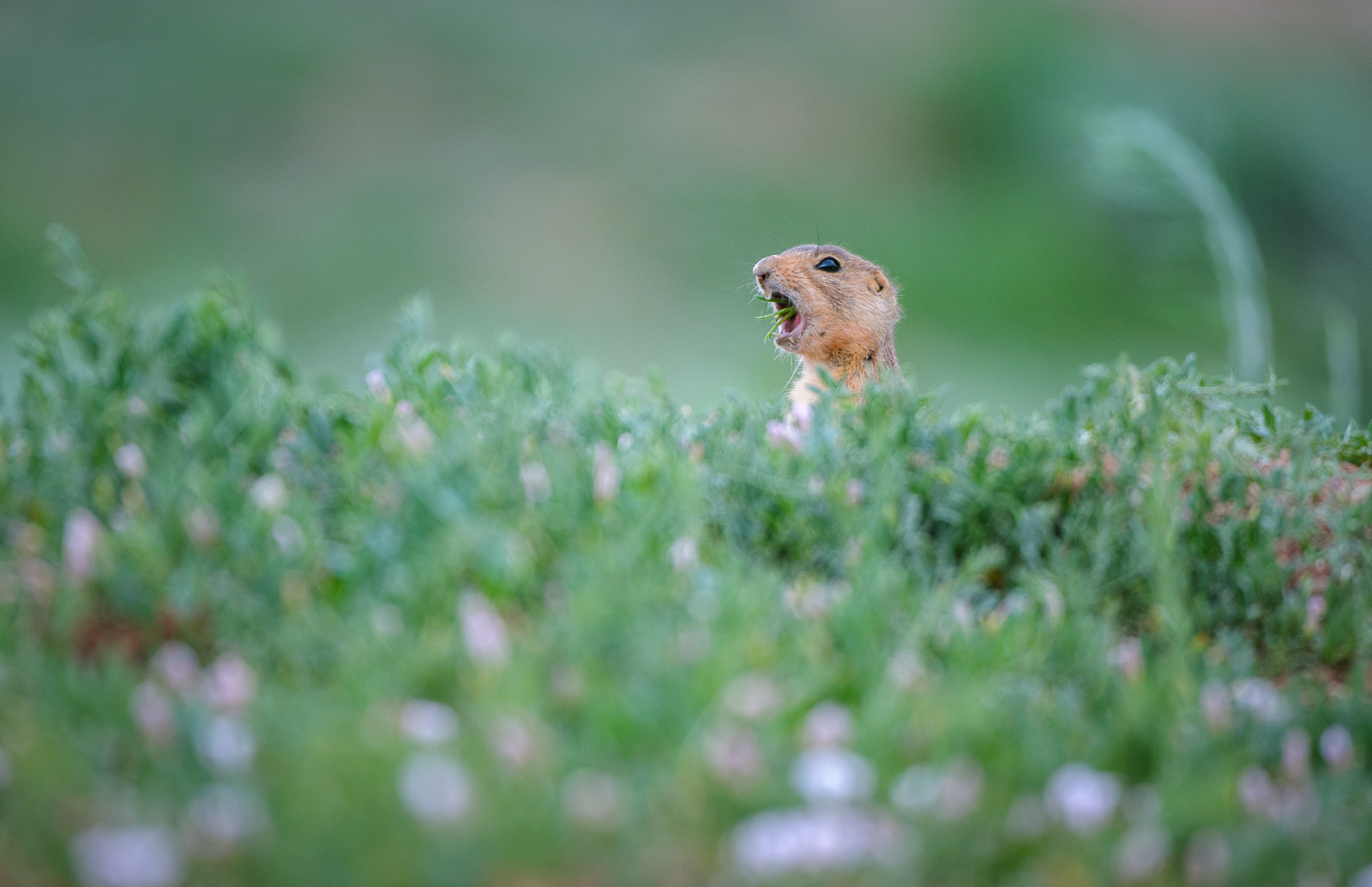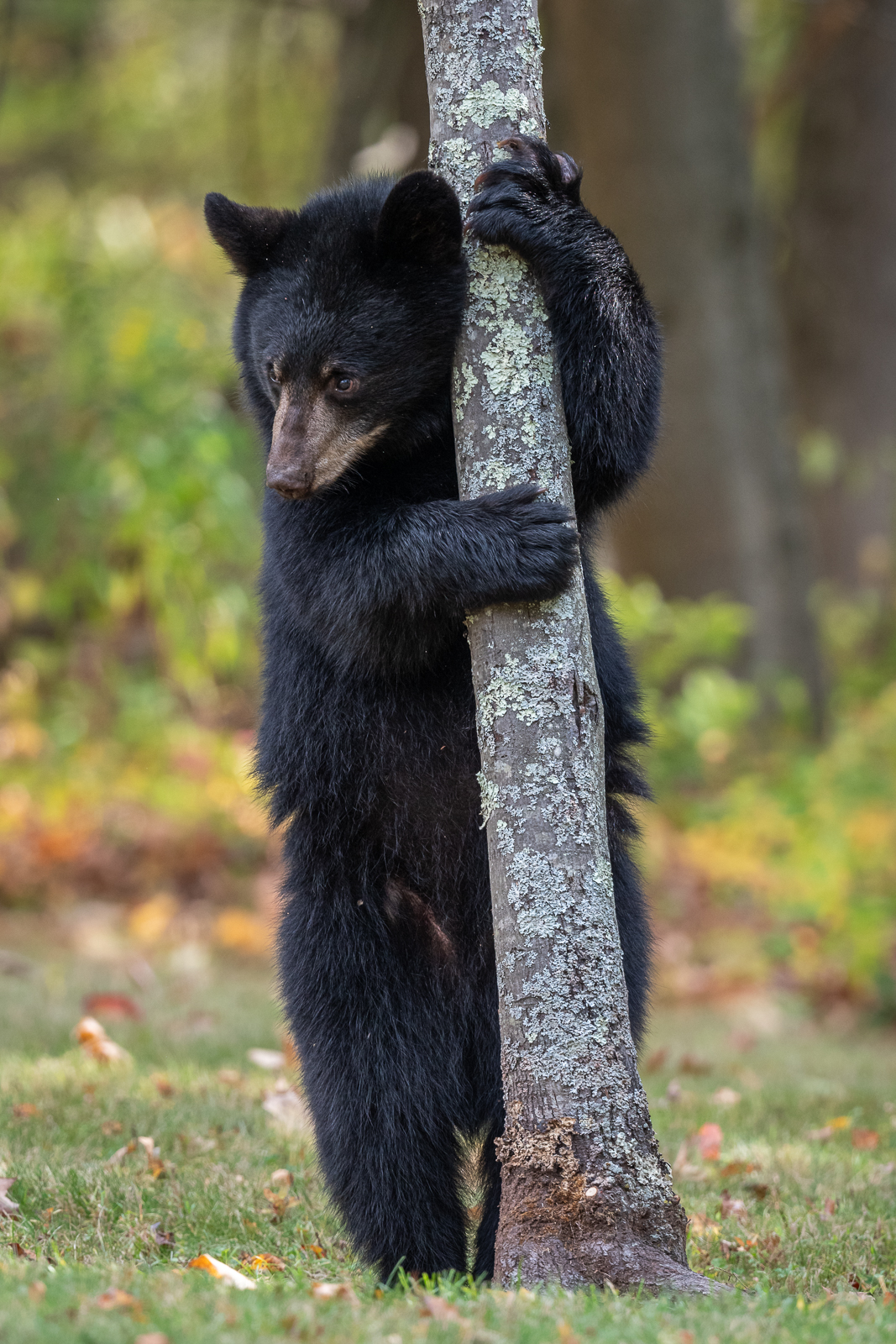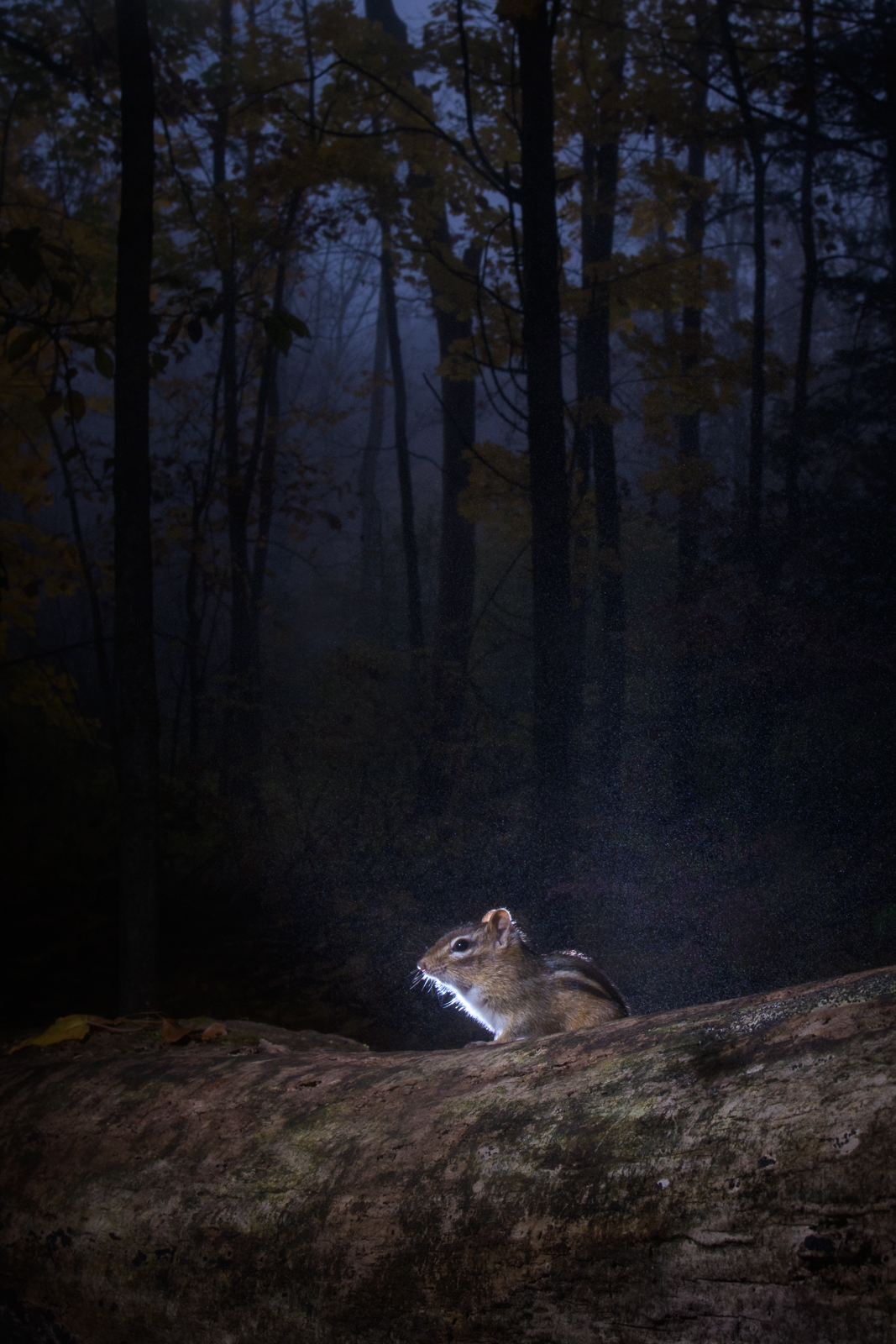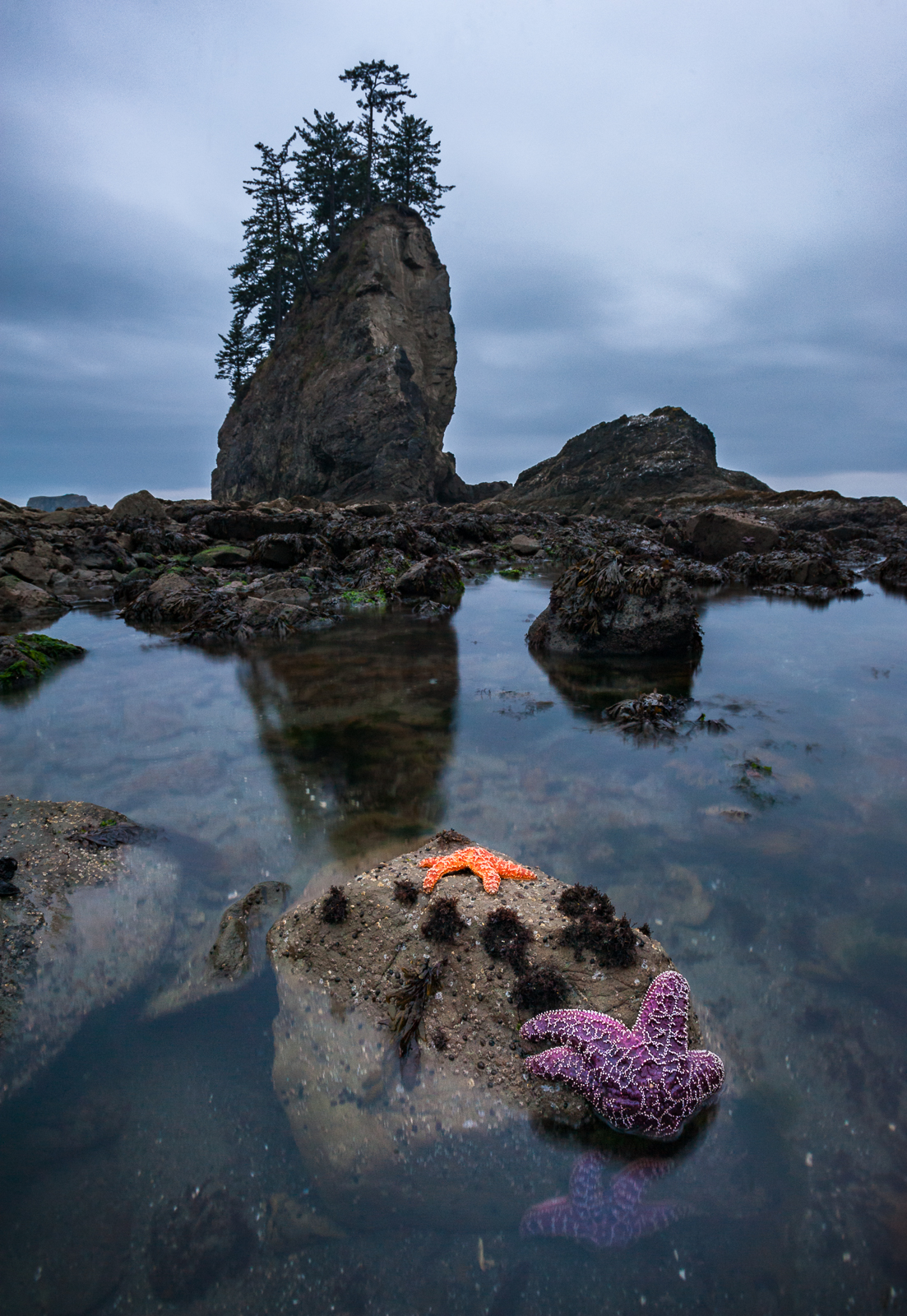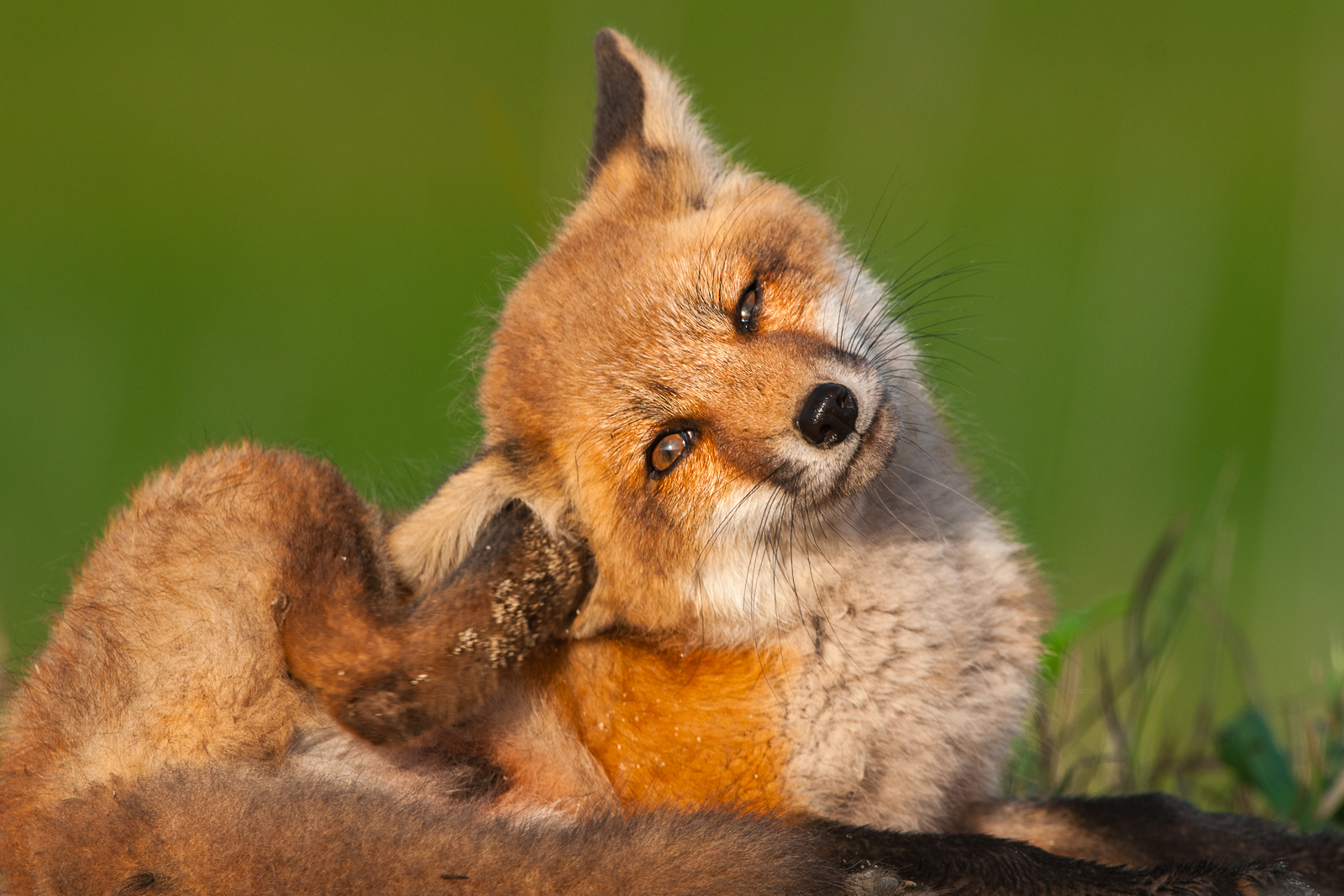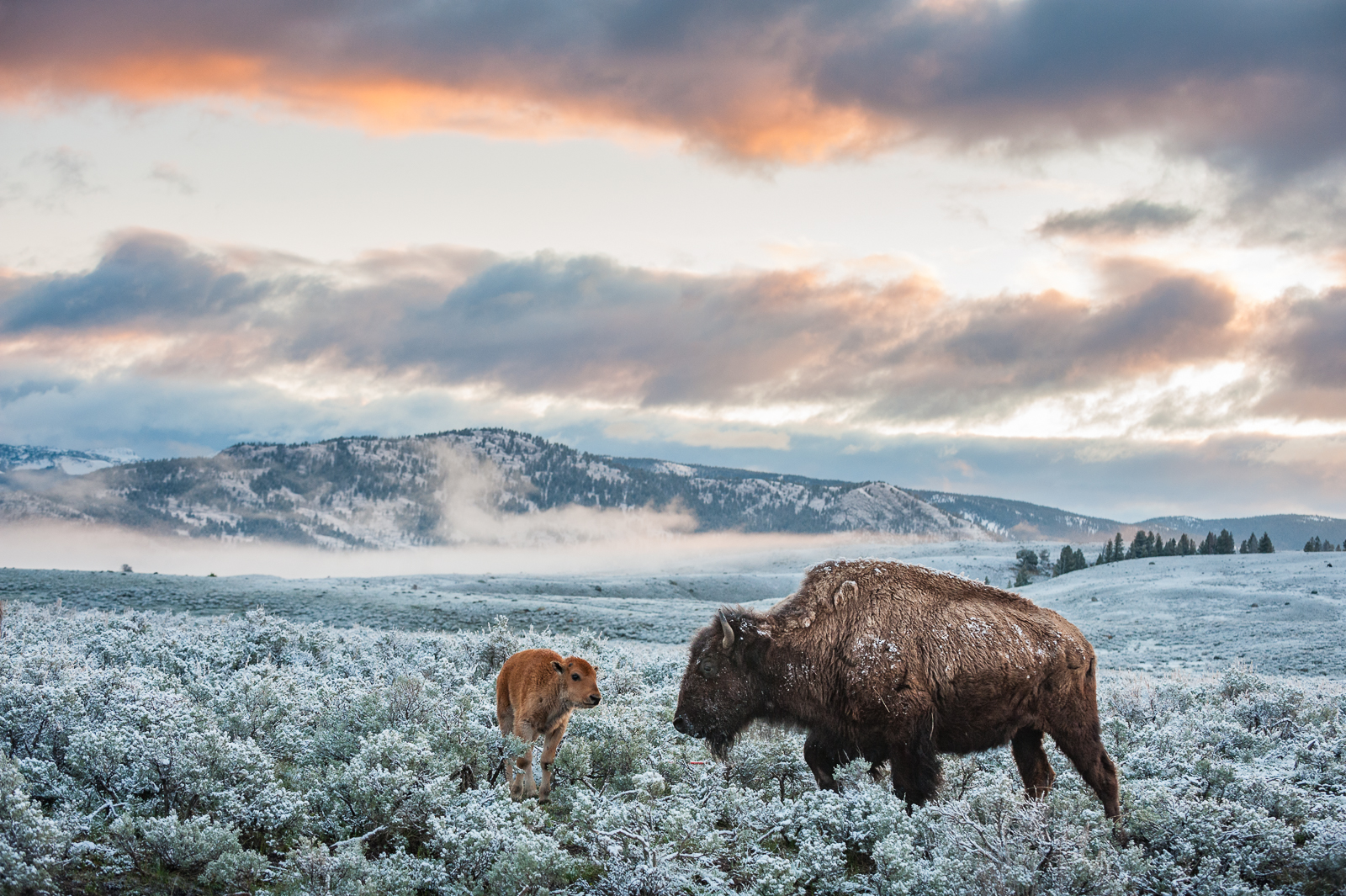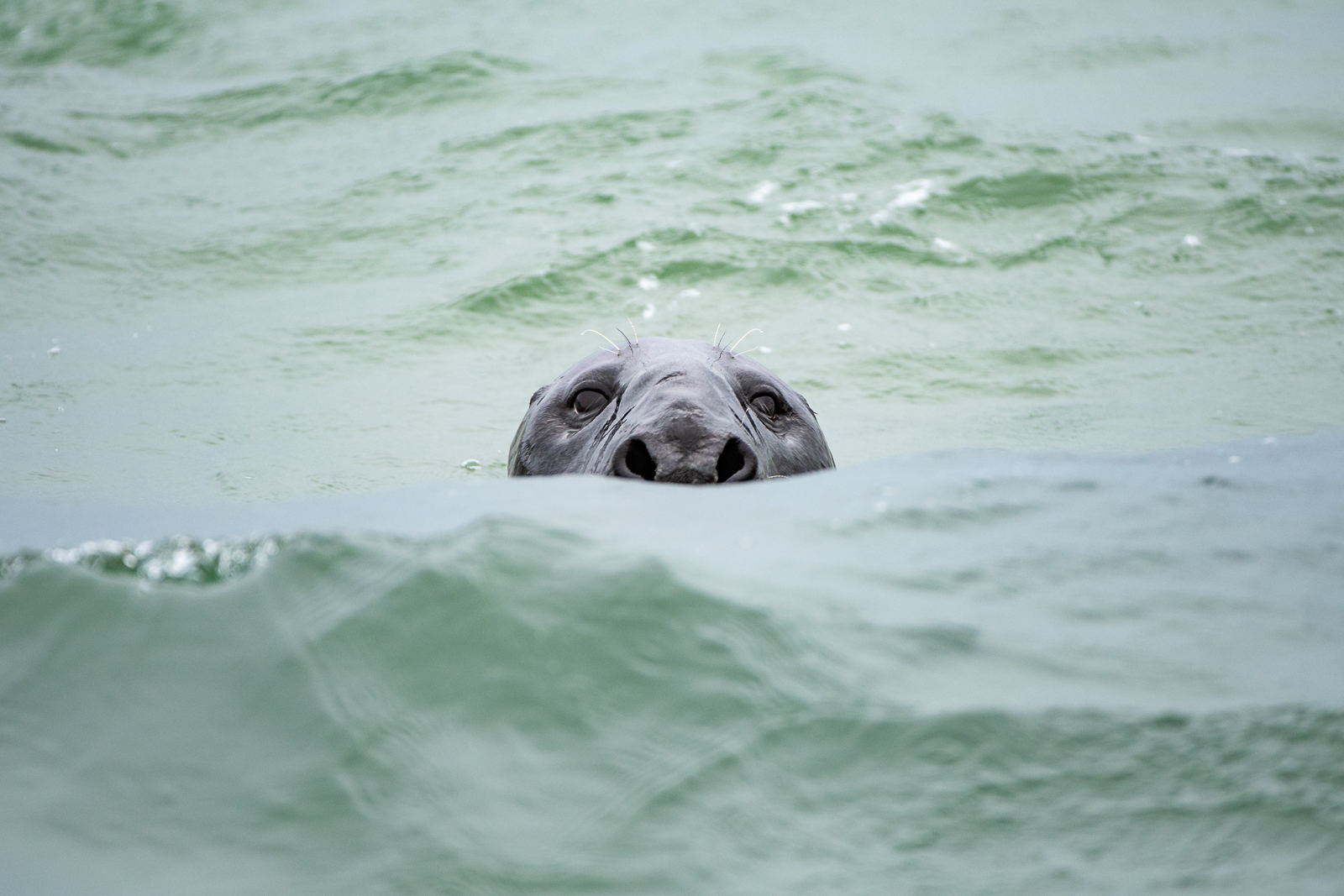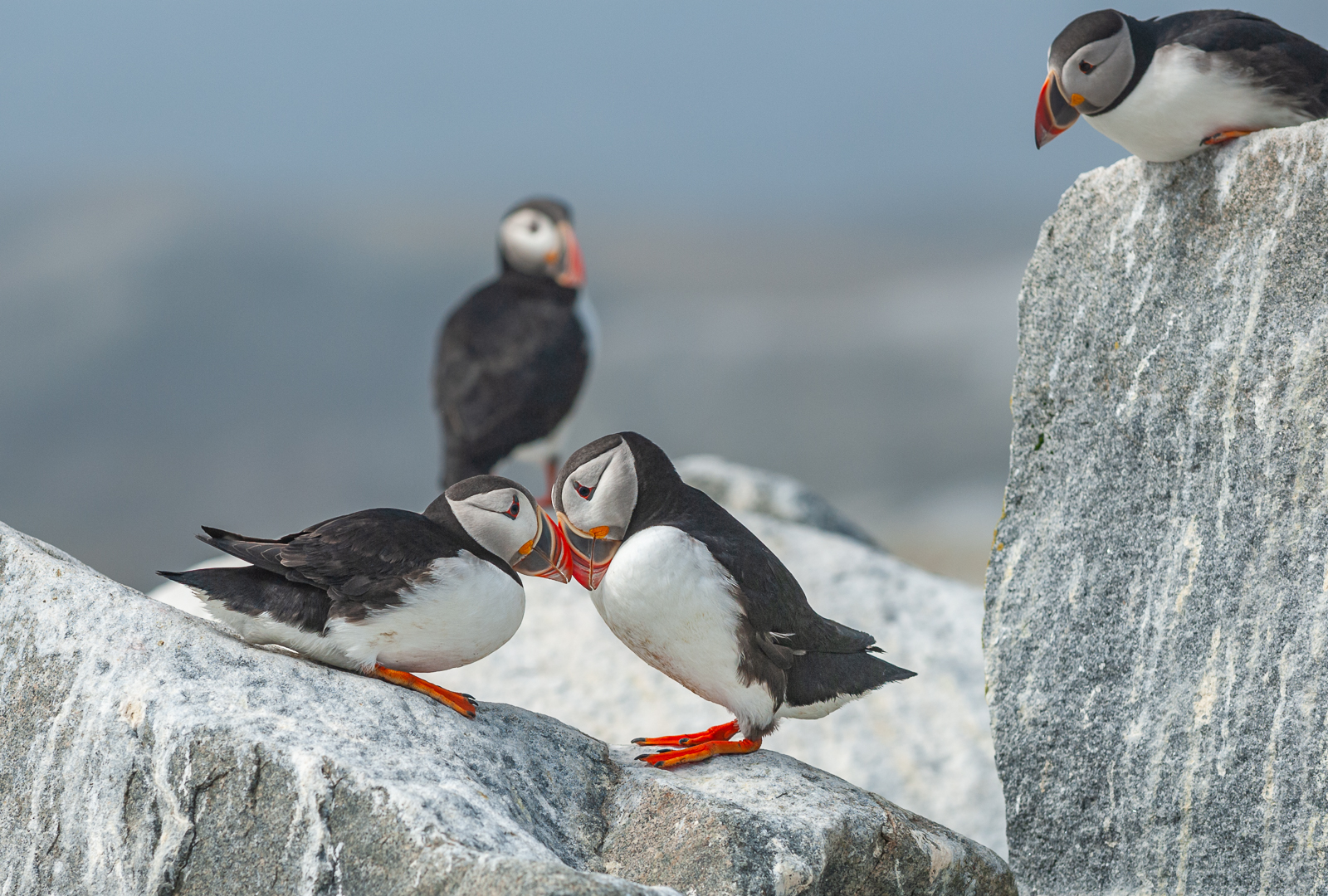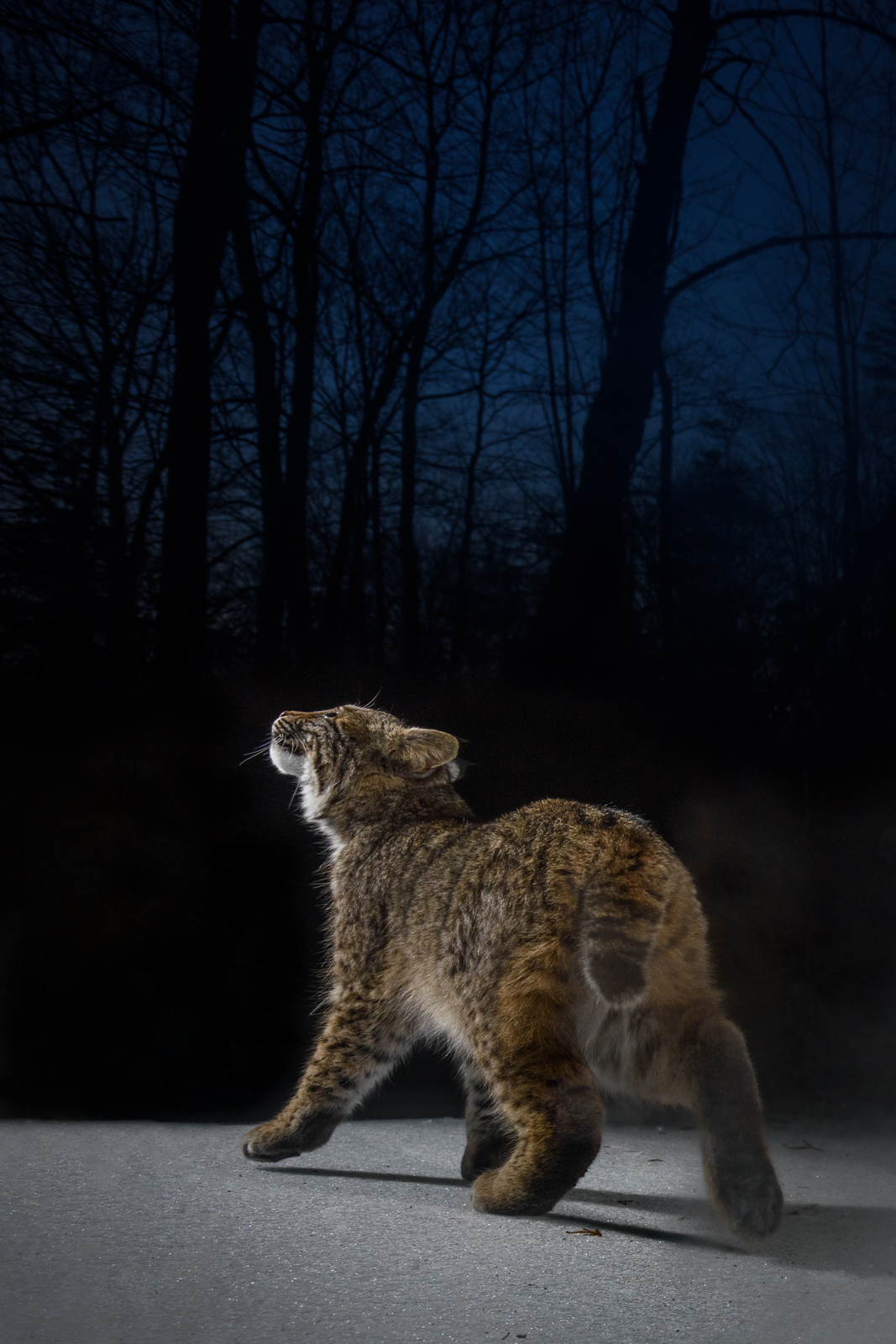Prairie Dog
 Prairie dogs are highly social and live in large underground colonies (or “towns”) with intricate tunnel systems and designated rooms for sleeping, nursing, and even waste (how about that fact — these guys actually have bathrooms). They also have one of the most sophisticated vocal communication systems in the animal kingdom, using different barks and chirps to warn each other of specific predators, including details like type, size, and direction. Who knows what description this guy was giving the rest of the town about the large man crawling in the bushes, interrupting lunch. Nikon D300 with Nikkor 200-400mm lens (at 400mm) ISO 400, f/4 at 1/250th of a second.
Prairie dogs are highly social and live in large underground colonies (or “towns”) with intricate tunnel systems and designated rooms for sleeping, nursing, and even waste (how about that fact — these guys actually have bathrooms). They also have one of the most sophisticated vocal communication systems in the animal kingdom, using different barks and chirps to warn each other of specific predators, including details like type, size, and direction. Who knows what description this guy was giving the rest of the town about the large man crawling in the bushes, interrupting lunch. Nikon D300 with Nikkor 200-400mm lens (at 400mm) ISO 400, f/4 at 1/250th of a second.
Ochre Sea Stars
 Here’s one from the archives. I visited Olympic National Park back in 2009 and spent a bit of time photographing ochre sea stars (Pisaster ochraceus). They are found up and down the Pacific coast, easily recognized by their orange, purple, or reddish hues. They play a crucial role as a “keystone species,” especially in rocky intertidal zones, by preying on mussels and helping maintain biodiversity. They can regenerate lost arms, and they feed by turning their stomachs outside their bodies to digest prey. They are also surprisingly strong for their size, and cling tightly to rocks with hundreds of tiny tube feet as waves crash over them. Nikon D700 with Nikkor 17-35mm lens (at 17mm) ISO 400, f/20 at 6 seconds.
Here’s one from the archives. I visited Olympic National Park back in 2009 and spent a bit of time photographing ochre sea stars (Pisaster ochraceus). They are found up and down the Pacific coast, easily recognized by their orange, purple, or reddish hues. They play a crucial role as a “keystone species,” especially in rocky intertidal zones, by preying on mussels and helping maintain biodiversity. They can regenerate lost arms, and they feed by turning their stomachs outside their bodies to digest prey. They are also surprisingly strong for their size, and cling tightly to rocks with hundreds of tiny tube feet as waves crash over them. Nikon D700 with Nikkor 17-35mm lens (at 17mm) ISO 400, f/20 at 6 seconds.
Red Fox Pup
 Red fox pups (Vulpes vulpes) are born blind, deaf, and completely dependent on their mother, spending the first few weeks nestled safely in a den. As they grow, pups become curious and playful, wrestling with siblings and pouncing on leaves or insects in mock hunting practice. These early games help build the skills needed to survive on their own. They begin to venture outside the den around four weeks old and are usually weaned by eight to ten weeks, but they’ll often stay with their family group through the summer, learning to navigate the world one cautious step at a time. I encountered this pup (also called a kit or cub) in Delaware, along with a few other siblings, alternating between playing and resting while they waited for their mother to return with breakfast. Nikon D300 with Nikkor 200-400mm lens (at 400mm) ISO 200, f/7.1 at 1/400th of a second.
Red fox pups (Vulpes vulpes) are born blind, deaf, and completely dependent on their mother, spending the first few weeks nestled safely in a den. As they grow, pups become curious and playful, wrestling with siblings and pouncing on leaves or insects in mock hunting practice. These early games help build the skills needed to survive on their own. They begin to venture outside the den around four weeks old and are usually weaned by eight to ten weeks, but they’ll often stay with their family group through the summer, learning to navigate the world one cautious step at a time. I encountered this pup (also called a kit or cub) in Delaware, along with a few other siblings, alternating between playing and resting while they waited for their mother to return with breakfast. Nikon D300 with Nikkor 200-400mm lens (at 400mm) ISO 200, f/7.1 at 1/400th of a second.
American Bison
 May can be a great time to visit Yellowstone National Park because you never know what kind of weather you’re going to get and it can change drastically from one moment to the next. Back in 2011, I visited later in the month and at times it felt like summer, at times winter, and on this morning, somewhere in-between. Frost and light snow was covering the landscape as the day began but by mid-day the sun was bright and the hills were green with new growth. And, of course, the great thing about Yellowstone is, when the conditions are right, there are always a few bison around willing and able to walk into the middle of the scene. Nikon D700 with Nikkor 70-200mm lens (at 70mm) ISO 800, f/5.6 at 1/320th of a second.
May can be a great time to visit Yellowstone National Park because you never know what kind of weather you’re going to get and it can change drastically from one moment to the next. Back in 2011, I visited later in the month and at times it felt like summer, at times winter, and on this morning, somewhere in-between. Frost and light snow was covering the landscape as the day began but by mid-day the sun was bright and the hills were green with new growth. And, of course, the great thing about Yellowstone is, when the conditions are right, there are always a few bison around willing and able to walk into the middle of the scene. Nikon D700 with Nikkor 70-200mm lens (at 70mm) ISO 800, f/5.6 at 1/320th of a second.
Gray Seal
 This one goes out to Chappy, the gray seal pup found mysteriously wandering around the city streets of New Haven a few weeks ago. He was exhausted and dehydrated when Mystic Aquarium took him in and did their best to nurse him back to health. He was showing signs of improvement but sadly took a turn for the worse and it was announced today that he didn’t make it. Gray seals are natives of the New England coastline. I photographed this one off the shores of Cape Cod. Nikon D500 with Nikkor 200-400mm lens (at 380mm) ISO 400, f/4 at 1/2500th of a second.
This one goes out to Chappy, the gray seal pup found mysteriously wandering around the city streets of New Haven a few weeks ago. He was exhausted and dehydrated when Mystic Aquarium took him in and did their best to nurse him back to health. He was showing signs of improvement but sadly took a turn for the worse and it was announced today that he didn’t make it. Gray seals are natives of the New England coastline. I photographed this one off the shores of Cape Cod. Nikon D500 with Nikkor 200-400mm lens (at 380mm) ISO 400, f/4 at 1/2500th of a second.
Puffin Love
 Another one from back in the day. I captured this image of Atlantic puffins on my first visit to Machias Seal Island off the coast of Maine. It’s an interesting place, and a disputed territory between the United States and Canada. We say it’s part of Maine. They say it’s part of New Brunswick. Canada owns the lighthouse on the island. Maine runs birdwatching tours and maintains a series of hides that allow for close encounters with nesting puffins, razorbills and other sea birds. Nikon D200 with Nikkor 70-200mm lens (at 160mm) ISO 100, f/4 at 1/2000th of a second.
Another one from back in the day. I captured this image of Atlantic puffins on my first visit to Machias Seal Island off the coast of Maine. It’s an interesting place, and a disputed territory between the United States and Canada. We say it’s part of Maine. They say it’s part of New Brunswick. Canada owns the lighthouse on the island. Maine runs birdwatching tours and maintains a series of hides that allow for close encounters with nesting puffins, razorbills and other sea birds. Nikon D200 with Nikkor 70-200mm lens (at 160mm) ISO 100, f/4 at 1/2000th of a second.
Bobcat on Snow
 I haven’t been up to check on the camera trap in a while because of all the ice. But the bobcat has been up checking on it, or at least walking around in front of it. And leaving no prints on that hard, crusty surface of the snow. Nikon D810 with Nikkor 17-35mm lens (at 20mm) ISO 500, f/14 at 1/250th of a second, Cognisys camera box, remote trigger and flash units.
I haven’t been up to check on the camera trap in a while because of all the ice. But the bobcat has been up checking on it, or at least walking around in front of it. And leaving no prints on that hard, crusty surface of the snow. Nikon D810 with Nikkor 17-35mm lens (at 20mm) ISO 500, f/14 at 1/250th of a second, Cognisys camera box, remote trigger and flash units.


